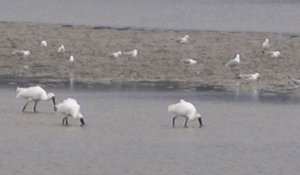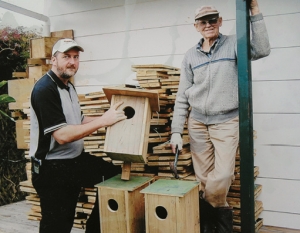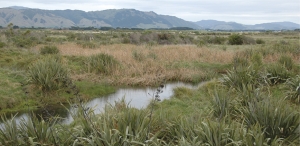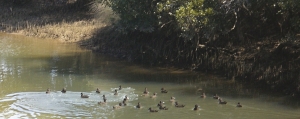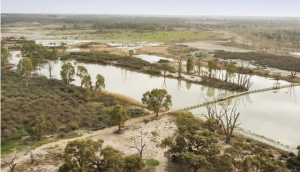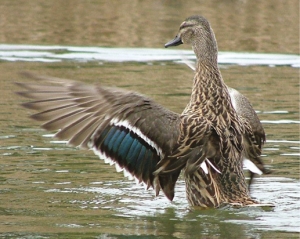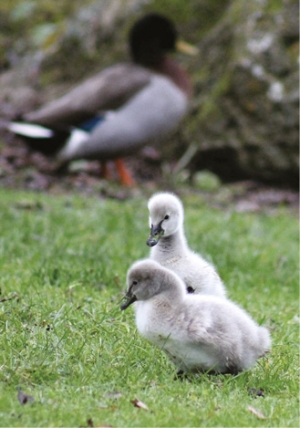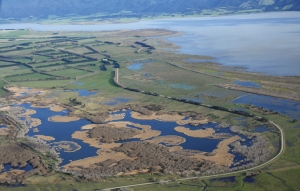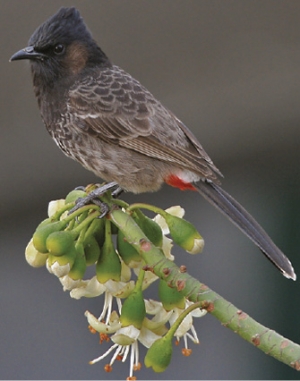Super User
First Whio duckling in 15 years
Staff at Pukaha Mount Bruce were excited in late October last year with the arrival of the first whio (blue duck) to be hatched there in over 15 years.
The only one of four eggs to hatch, the duckling was raised with three other ‘exotic’ ducklings. The duckling’s mother was then put on another clutch of eggs and with hopes for a better hatch rate from the second clutch.
Staff are still unsure of the sex of this first whio. At approximately six months old a male whio will whistle when picked up and a female whio will grunt.
Australian invader
Yet another immigrant from Australia, royal spoonbills were known to Maori as kotuku ngutu papa so must have visited here for many years. Their numbers seem to have increased in the early 1940s. Some settled in the Waitangiroto River at Okarito. They have extended their range and now breed in a number of places, including Kapiti Island and Parengarenga and Manakau Harbours. There was a report of a colony up the Waiuku River. Royal spoonbills tend to breed near kotuku, shag and gull colonies. Some nests are high in kahikatea trees, others on low shrubs or on the ground. The birds assemble at nesting sites about October and begin their courting behaviour.
Spoonbills feed on insects, shellfish, small fish and frogs. They are readily identified in the distance by the way they feed, walking and sweeping their spoon bill in an arc, often knee deep in water. They feed day or night, whenever the tide is right.
Building and erecting Grey Teal nest boxes
These nest box instructions were first used in an early Flight, and have proved very effective since then. So for the handy men and women among our members here is a new occupation for you over the summer months.
Introduction
Since its inception in New Zealand, Ducks Unlimited has been advocating the provision of nest boxes as a way of increasing the number of Grey Teal in the country. This project known as “Operation Gretel”, was the first project undertaken by DU in New Zealand and has already seen over 900 nest boxes erected in different parts of the country.
As Grey Teal are usually hole nesters, there is a common belief that their numbers in New Zealand are limited by a shortage of nest sites, compared with Australia. Therefore, the provision of artificial nest sites, in the form of boxes, is a potentially powerful management technique for increasing both the number and range of Grey Teal. Probably the most successful example of this is the management of Carolina Wood Duck in North America, however, nest boxes are also used successfully for the management of other species in both North America and Europe. The attached plans cover the construction, mounting and servicing of two different designs of Grey Teal nest box. The front entry box is the type most widely used, however, the alternative side entry may be preferred by some people as it is possibly more weather and predator proof. Its main disadvantages are the extra material, and hence cost, required to build it, and its more complicated fabrication.
The plans for both designs are based on the use of 2400mm x 1200mm sheets of 9mm plywood which is suitably treated for exterior use. For each design there is a cutting plan, to ensure the correct number of components are cut from each sheet, while minimising waste, and an assembly diagram, to illustrate correct overlaps. Thicker plywood may be used for a longer life, however, this will entail some dimesional alterations. Suggestions for mounting each box type are also included.
Construction
The dimesions on the cutting plans are all in millimetres, and are finished sizes. This means that most of the waste shown around the edges of the sheets will be consumed by the thickness of the saw blade multiplied by the number of cuts made. One sheet of plywood will yield enough components to build six front entry boxes or four side entry boxes.
Galvanised flat head nails, or non-corroding screws, should be used to assemble the boxes and for added strength, lengths of 20mm square timber can be used in the corners of the boxes. This will provide something more substantial for the nails and screws to hold onto and will help prevent the ply splitting when nailing or screwing into the edge of a component. To minimise the amount of reinforcing timber needed, it should be used along the top and bottom edges of the two sides on the front entry box, while on the side entry box it should be placed vertically along both edges of the front, and on the back, where the sides join. In both cases allowances will have to be made for the recessed bottom.
The entry hole of the front entry box should be 90-95mm in diameter as anything bigger could allow larger waterfowl to enter the box and evict the Grey Teal. The centre of the hole should be on the cenreline of the front, about 90mm from the top edge. A strip of chicken wirenetting must also be fixed on the inside of the front, from the bottom edge of the entry hole to the bottom of the box. This allows the ducklings to climb out of the box once the female decides to lead them away.
The side entry box is not as deep as the front entry box so it is easier for the ducklings to escape. However, because plywood has a smooth finish to it, a strip of wirenetting should also be fixed on the inside of these boxes as well.
On the assembly diagrams, the boxes are shown with the lids removed. The dashed detail shows the suggested lid overlap of the box’s four sides, which will help keep the box weatherproof. When fitting the lid, which has to be removable, short lengths of the 20mm square timber can be fixed to its underside to fit tightly inside the four vertical sides of the box. The lid can then be be weighted down with something heavy, or be secured with screws.
The bottom of both box designs are fully recessed and holes may be drilled through them to allow the drainage of any water which does manage to get in. If required, the side entry box can be assembled with either a left or right entry be simply rotating the back and swapping the two sides.
Mounting
Boxes should be securely mounted on a pole, with the bottom about 1m above water level. If necessary, allow sufficient clearance for the pond’s water level to rise during floods. Poles should be driven into the bottom of the pond, in open water, clear of overhanging vegetation as weed mats and overhanging branches give predators access to the boxes. At the same time, it is beneficial to locate the boxes in the lee of tall vegetation to provide them with shelter. Boxes can be erected in lines or small groups, however they should not be close than 4-5m as neighbouring birds can provide sufficient disturbance to lead to nest desertion. As a result, two boxes cannot be erected back to back on the same pole.
Boxes can be mounted by simply nailing or screwing them to the pole permanently, however, there are advantages to be gained from mounting boxes in a way that will allow them to be easily removed for servicing. The use of half round poles will also give a flat surface to mount the box on to. Mounts can be made out of 50 x 50mm tanilised timber, such as fence battens. For the front entry box a 230mm length of timber should be fastened within 10mm of the top edge of the back and should be drilled with two vertical holes to carry locating pins. On the pole a second 230mm length of timber should be fastened with its top edge 50mm below the top of the post. This should also be drilled with two vertical holes corresponding to those on the box mounting, however, they should remain blind. A short block should be fastened further down the post with its top edge 340mm below the top of the post. The box can then be mounted by resting it on the top post mounting and dropping long nails through the extended back of the block.
The side entry box can be mounted in a similar way, however, the mounts should be 260mm long and only extend across the back of the main nest box, not the side entry. A different bottom mount will also be needed. Instead of a block, a further 260mm mount should be fastened to the box close to the bottom edge of the back. A second mount should be fitted to the post in such a position that the top box mount fits over the top post mount while the bottom box mount fits tightly under the bottom post mount. Both the top and bottom mounts can then be secured using simple locating pins, as on the front entry box, yet these still allow the box to be easily removed from its post.
Servicing
Grey Teal begin prospecting for nest sites in late May and June, and eggs can be expected from July onwards, so long as water conditions are suitable. Nesting may also continue into December, or even as late as January or February in exceptional years. However, because waterfowl do not carry nesting material to their nesting site, the boxes must be furnished with suitable material, such as dry hay or straw, before nesting season.
Once Grey Teal have finished using the boxes it is usual for Starlings and Mynas to take them over, and as these birds do carry nesting material to their nest site it is common to find a box completely filled with dry grass once they have finished with it. Therefore, the boxes will need to be cleaned out and provisioned with fresh nest material each year. This is best done about May as the Starlings and Mynas should have finished nesting yet the Grey Teal would have started. An annual clean out will also reduce the risk of disease and parasite infestation for the Grey Teal. The bottom of the box should be covered with 50-75mm of nesting material, enough for the female to fashion it into a nest bowl without the eggs having to sit on the bottom of the box.
If all goes well, the boxes will start being used by Grey Teal as soon as they have been erected. However, if pinioned birds are present they will need to be given access to the boxes via a ramp. This can be made simply out of a piece of 100 x 25mm timber either covered with wirenetting, or having shallow cross cuts in it, for the birds to grip on to as they climb up to the box entrance. The ramp should extend down to water level, but remember this could give predators entry to the box as well.
World Wetlands Day and beyond
The plight of the world’s wetlands is highlighted annually by World Wetlands Day, and the 2011 celebration also coincided with the 40th anniversary of the Ramsar Convention - an international agreement to promote and protect freshwater environments. See page 14.
Since the agreement was signed in 1971, 186 million hectares of wetlands have been protected throughout the world - including 55,000ha in New Zealand.
Since European settlement New Zealand has lost more than 90 percent of its wetlands - many drained to create farmland and supposedly help with flood control.
Now the Department of Conservation (DOC) and community groups are working to redress the balance aiming to educate people about the importance of wetlands - rated amongst the most important, productive and highly threatened ecosystems in the world.
Wetlands provide a range of crucial ecosystem services such as improving water quality, controlling extreme flooding, regulating carbon levels and supplying fresh water.
Threatened wildlife
DOC refers to wetlands as “cradles of biological diversity” and says they support a high number of threatened plants and animals, as well as providing the greatest concentration of birdlife than any other habitat in New Zealand.
Wetlands are especially important to Māori and have historical importance having provided abundant supplies of food and materials used in everyday life during early times. Flax was used in clothing, mats, kits and ropes; raupo for thatching and dried moss for bedding. Eels, fish and birds from the wetlands were a good food source, and the feathers of birds like the pukeko and bittern were used to adorn cloaks and other garments. The waterways were also an important means of access by waka or canoe. New Zealand species New Zealand wetlands have exceptional habitats - 47 species of rush and 72 species of native sedge alone - as well as a number of endangered plant species that totally depend on the wetland environment.
Migratory birds also depend on chains of suitable wetlands and the survival of threatened species such as the Australasian bittern, brown teal, fernbird, marsh crake and white heron all rely on New Zealand’s remnant wetland areas.
Native fish also need wetlands and eight of New Zealand’s 27 species including inanga, short-finned eels, kokopu and bullies are found in wetlands. Whitebait also spawn in freshwater wetlands.
Pateke doing well
Pateke Spotter: On the October 5 last year, Wayne Watson counted 32 Pateke at Whananaki, on Northland’s east coast - just north of Whangarei.
DU released Pateke at Whananaki in the 1980s and while they survived for long periods the massive predator expansion in Northland caught up with them, but now there is some serious predator control taking place on Northland’s east coast with very positive results.
Banrock Station wetlands get a boost
Nearly 700 hectares of wetlands at Banrock Station are being artificially flooded. This is the first time in five years the area near Kingston-onMurray, has seen flooding.
Banrock Station, in the South Australian Riverland, is on the Ramsar list of internationally significant wetlands.
A new regulator is pumping 2.4 gigalitres of water into the wetlands, a task which will take the next year.
Wetlands manager Christophe Tourenq said the process should mimic the natural wet-dry cycles of the flood plain, boosting the health of native plants and wildlife in the area.
Christophe said they had high water levels all spring and after that water levels would be reduced a little bit during summer.
“After that, again high levels next winter and then we start again to have a dry wetland in two years time.”
He said the process would recreate what happened before the construction of locks and weirs along the Murray River.
Story courtesy Wetland Care Australia.
Operation Duck Pond
With about 90 percent of New Zealand’s wetland lost over the past 150 years, Fish & Game NZ realises there’s a compelling need to assess the role that ponds play in successfully managing waterfowl.
Ponds have been established across the New Zealand landscape for various purposes including stock watering, irrigation, storm water capture, effluent ponding, waterfowl habitat and simple aesthetic values. Currently, there’s little scientific information on what, and how big a role these ponds play as habitat for waterfowl populations.
The aim of this ‘citizen science’ project is to determine what pond habitat features provide good breeding for waterfowl, and promote good pond management practices for breeding these birds. Fish & Game has launched an appeal for people who want to monitor waterfowl populations on ponds around their area. The aim is to establish a network of ponds to be closely monitored over the breeding season.
You don’t have to be a scientist! All volunteers will be given a set of simple instructions on how to go about monitoring. Fish & Game will supply a manual with simple instructions on how to run their surveys – so everyone round the country is tackling the project the same way, and volunteers gather the best data possible.
If you’re keen to help with collection of data and are prepared to monitor a pond, a fun and fulfilling project that will help New Zealand’s waterfowl and other native water dependant birds, this project is for you. Don’t forget – we are keen to hear from a wide range of people, including youngsters. Kids – depending on your age, you may need to line up support from mum and dad, a friend or relation.
Your help in this project will not only provide data to drive management decisions, but will give waterfowl enthusiasts, hunters and landowners a unique opportunity to get involved and make a real hands on contribution to our efforts to manage waterfowl – and keep their numbers up!
An eye for the birds
As a cataloguer in the library at Massey University in the Manawatu Judi is in just the right place to follow her interest in photography and birds. These photos were taken beside the small lake in the University grounds.
Watch out predators – Steve’s on the job
In late November Steve Playle did a trap run at Boggy Pond and Wairio. The count was 1 ferret, 1 rat and 10 hedgehogs.
“The ferret was a big bugger and was caught along the stop bank between Mathews and Boggy. This took the total predator count to 23 ferrets, 1 stoat, 2 weasels, 4 cats, 5 rats and 14 hedgehogs.” said Steve.
Rampant growth of grass and weeds along with warm weather meant extra time cleaning around trap sites. Steve also put out another seven DoC250 traps on the Wairio Restoration Block along with two more timms traps along a pine belt where cats have been seen.
Stock tends to interfere with the traps in the Wairio Restoration Block. “We have to live with that unfortunately,” said Steve.
Mice also play havoc with baits with most traps stripped of meat if they have not had a kill in them. Steve said he knows it’s mostly mice because the DoC traps have mouse droppings in them. He has seen mice in the timms traps too. “With only one ferret for this check it could mean their numbers and getting down or maybe they are feasting on mice or even frogs as the place is alive with them at the moment,” said Steve.
Steve has seen and heard bitterns and another was heard at Mathews pond.
Trapping is ongoing.
Big reward for capture of bulbul
If you live in the Auckland region and see or hear a Red-vented bulbul, ring 0800 08 99 66 and you could receive a $1000 if your information leads to a capture. Reward period runs to the end of February.
The reward for information leading to the capture of this pest bird was increased from $300 to $1000 in October last year. The reward is for information that leads to the capture of this invasive pest. Capturing and eliminating this bird is important.
Red-vented bulbuls can cause significant damage to fruit and vegetable crops and they chase and attack other birds. The Ministry for Primary Industries, Department of Conservation (DOC) and Auckland Council are working together to track and eradicate the red-vented bulbul in Auckland.
The response team working to eradicate this pest bird, which comes from Asia, need information of sightings.
“We’ve had more than 70 calls about possible sightings since we offered the $300 reward, but are still working to capture one of these birds,” said DOC spokesperson Liz Brooks. “We’re asking the public to keep looking for red-vented bulbuls and to call 0800 80 99 66 if they think they see one. To encourage this we increased the reward to $1000 for a call that leads to a capture,” said Ms Brooks.
“We think there are at least five red-vented bulbuls in Auckland which most likely arrived by ship or yacht. They’ve arrived in Auckland twice before and were successfully eradicated. We want to eliminate them before they make themselves at home,” said Ms Brooks.
The red-vented bulbul is one of the most invasive bird species in the world and in New Zealand is listed as an unwanted organism under the Biosecurity Act 1993. The maximum penalty for importing, trading, releasing, exhibiting or breeding a red-vented bulbul is five years in prison or a fine of $100,000.
Red-vented bulbuls are confirmed to be located in three clusters in Auckland: south Auckland (Mangere /Manurewa/ Alfriston), west Auckland (Henderson / Te Atatu / Massey) and on the North Shore (Devonport / Belmont / Takapuna). There’s also been a confirmed sighting on the Whangaparaoa Peninsula.
There have also been unconfirmed sightings in Orakei, in central Auckland, and at Walton, between Morrinsville and Matamata in Waikato.
Keep an eye and an ear out for red-vented bulbuls. They have a very distinctive call, unlike other birds. They are easy to spot, a medium-sized bird, around 20 centimetres in length, about the size of a starling. They have a black head, a dark back, grey-white belly, and a distinctive crimson-red patch beneath their tail. Call 0800 80 99 66.
Their distinctive call can be heard at: http:// www.biosecurity.govt.nz/pests/red-ventedbulbul.

